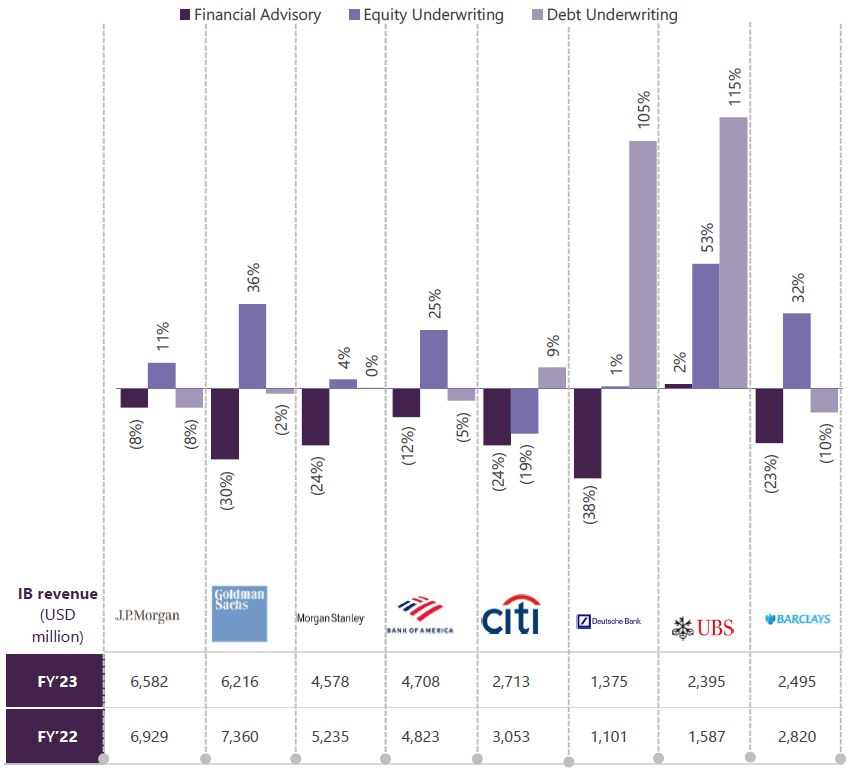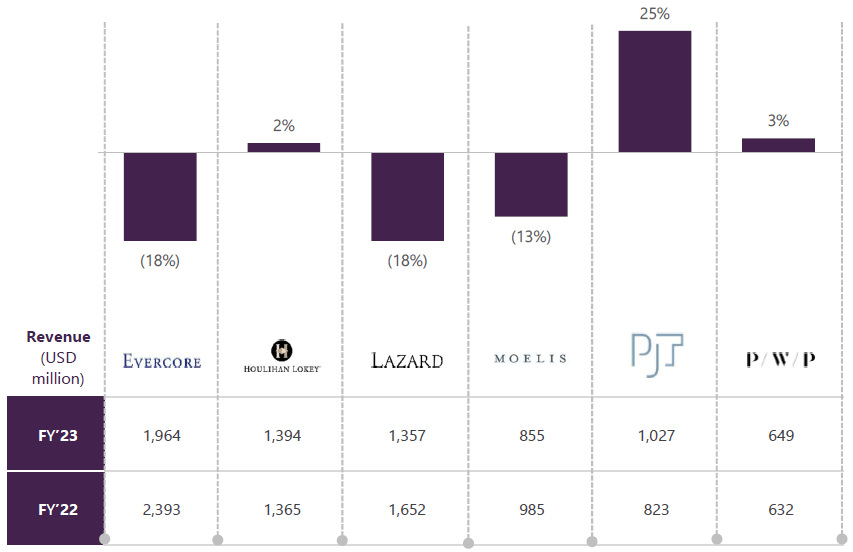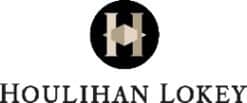Highlights – FY’23
M&A activity falls to a 10-year low
M&A deals declined by 17% to USD2.9 trillion across the globe in FY’23, compared with USD3.5 trillion in FY’22, marking the slowest full-year period for deal-making since 2013. However, Q4’23 witnessed a 23% increase in deal activities, compared with Q3’23, making it the strongest quarter for M&A activities across the world since Q2’22.
Region-wise, M&A activities in Europe, APAC, and the US were down by 28%, 26%, and 5%, respectively, on a year-on-year basis. High inflation, high interest rates, and geopolitical tensions continued to weigh on M&A activities globally. In sectoral trends, the energy and power sectors led the mix, accounting for 17% of total deal-making activities. On the other hand, the industrial and healthcare sectors accounted for 13% each in the overall M&A activities in FY’23.

Debt capital markets remain solid
In FY’23, global debt capital market (DCM) activity was valued at USD8.9 trillion, up by 6% compared with FY’22, making it the strongest opening period for DCM since 2021. Meanwhile, new DCM offerings increased by 8% YoY to a two-year high. During FY’23, investment-grade corporate debt issuances were up by 5% YoY. Also, high-yield issuances continued their strong momentum and were up by 66% YoY. Green bond issuances totaled USD422.3 billion, up by 10% YoY, making it the largest full-year period since FY’21. In sectoral activity, the media and entertainment, consumer, and energy and power industries registered double-digit percentage increases, compared with FY’22 levels. However, the retail and telecommunications industries led the list of decliners.

ECM activity reaches a two-year high
Global equity capital market (ECM) activity was valued at USD528 billion in FY’23, up by 7% YoY, marking the strongest full-year period in two years. The US accounted for 26% of the overall issuances and recorded a 62% growth, compared with FY’22. ECM in China fell by 33% YoY, marking the lowest percentage of global ECM during a full-year period since 2019. Global IPOs, excluding SPACs, stood at USD112 billion, down by 24% YoY, marking the slowest full-year period for global IPOs since 2009, despite a strong show from US listings, which more than doubled in the same period. Convertible offerings, which stood at USD93 billion, were up by 34% YoY and accounted for 18% of the ECM activity. Industrials, technology, energy, and power were the most active industries and together accounted for 50% of the overall issuance of convertible offerings.

Top five M&A deals
|
Date of announcement
|
Acquirer’s Name
|
Acquirer’s Location
|
Target
|
Target’s Location
|
Value (USD billion)
|
Target’s Industry
|
Deal type
|
|---|---|---|---|---|---|---|---|
|
Oct 11, 2023
|
Exxon Mobil
|
US
|
Pioneer Natural Resources
|
US
|
60.3
|
O&G
|
Stock
|
|
Oct 23, 2023
|
Chevron
|
US
|
Hess
|
US
|
52.9
|
O&G
|
Stock
|
|
Mar 13, 2023
|
Pfizer
|
US
|
Seagen
|
US
|
43.8
|
Healthcare
|
Cash
|
|
Sep 21, 2023
|
Cisco Systems
|
US
|
Splunk
|
US
|
28.1
|
Tech
|
Cash
|
|
May 12, 2023
|
Black Spade
|
Hong Kong
|
VinFast Auto
|
Vietnam
|
23.0
|
Auto
|
SPAC
|
Unfavorable market continues to create headwinds for global investment banks
Investment banking revenues of major investment banks declined in FY’23, due to weak market conditions globally, leading to a sharp decline across all areas of business. A halt in deal-making amid uncertain macroeconomic outlook, high inflation, and geopolitical tensions were the main factors responsible for the decline. Market performance is expected to improve in 2024, due to pent-up demand for M&A and a strong pipeline, provided the macro environment remains stable.

Note: Revenue for Deutsche Bank and Barclays were converted into USD using the exchange rate as on Dec 31, 2023; Revenue for Deutsche Bank reflects revenue from Origination & Advisory services; Revenue for UBS represents standalone for FY’22, and for FY’23 represents proforma for Credit Suisse post completion of acquisition in June 23
Bulge bracket investment banks – Performance highlights
JP Morgan’s investment banking (IB) revenue and IB fees were up by 13% each YoY in Q4’23, driven by high debt and equity underwriting fees. Also, reflected the modest growth in advisory business, increasing by 2% YoY in Q4 2023. The Underwriting fees were significantly up with debt by 21% and equity by 30% YoY in Q4 2023. In terms of outlook, the bank has begun to march down the path towards normalization of its returns. However, it announced that M&A remains a headwind, and the extent and timing of normalization in capital markets remains uncertain.

Goldman Sachs’ IB fees declined by 16% YoY in FY’23, due to significantly low net revenues in advisory, reflecting a notable decline in industry-wide completed M&A transactions. The bank witnessed slightly low net revenues in debt underwriting, which was partially offset by significantly high net revenues in equity underwriting, reflecting increased activities from secondary offerings. The bank is encouraged by the robust levels of dialogues with its corporate client base and solid levels of capital markets activities in the US and Europe.
Morgan Stanley’s IB revenue declined by 13% YoY in FY’23, due to fewer completed M&A transactions on low market volumes. The bank’s advisory revenues have begun recovering compared with recent quarters and were roughly flat on a year-on-year basis in Q4’23. Revenue from equity underwriting was flat, as activity remained muted. Fixed income underwriting revenues were essentially unchanged on a year-on-year basis, as high investment grade issuances were offset by low non-investment grade issuances. The bank is positioned to capitalize on the opportunity set, while the downside risks are linked to the consumer, with the rate path and geopolitics as two key determinants. Also, the CEO and boardroom optimism is growing, evidenced by the bank’s advisory and IPO pipelines.
Bank of America’s IB fees fell modestly in FY’23, compared with FY’22, despite a feel pool that was down by 8%. Revenue from the advisory and debt underwriting businesses declined by 12% and 5% YoY, respectively, in FY’23, whereas revenue in equity increased by 25% during the same period. Total investment banking fee was up by 7% YoY in Q4’23, indicating the bank’s IB business is performing well in a sluggish environment. The bank added new commercial business banking clients, which will help in midmarket investment banking activity.

Citi’s IB revenues increased by 27% YoY in Q4’23, driven by debt capital markets and advisory. The upside was partially offset by downside in equity capital markets. IB fees in advisory increased by 11% YoY in Q4’23, reflecting high client activities, in DCM increased by 43% YoY in Q4’23, driven by non-investment and investment-grade activities and in ECM decreased by 17% YoY in Q4’23, due to geopolitical concerns and general IPO market conditions. In the advisory business, the bank sees signs of strength across technology, healthcare, and energy sectors and has an optimistic outlook given the strength of its pipeline.

Deutsche Bank’s revenue from origination and advisory (O&A) business increased by 25% YoY in FY’23, driven primarily by debt origination business which benefited due to the nonrecurrence of the prior year’s mark-to-market losses in leveraged debt capital markets partially offset by a 38% decline in advisory revenue, reflecting very low industry activity. The bank aims to generate EUR32 billion in revenue in 2025 and has invested to drive growth in capital-light businesses, notably in the corporate bank, origination and advisory, and wealth management businesses. Further, the bank completed the acquisition of Numis, which, the bank believes, will accelerate this strategy in the UK.
UBS’s global banking revenues increased by 69% YoY in Q4’23 with fee-pool outperformance across all regions. Advisory revenue increased by 11% YoY in Q4’23 mainly due to higher M&A transaction revenues, which increased by 14%. Capital markets revenues increased by 305% YoY in Q4’23, mainly attributable to the consolidation of Credit Suisse revenues and included USD 275m of accretion effects. Excluding the accretion effects, underlying capital markets revenue increased by 133% YoY in Q4’23, mainly due to increases across Leveraged capital markets, Debt capital markets and Equity capital markets. With improving market activity, a growing banking pipeline and advanced progress on integration, the bank expects the IB business to return to profitability in the Q1’24.

Barclays’ IB fees were down by 12% YoY in FY’23, due to the reduced fee pool across advisory and debt capital markets. The downside in fees was partially offset by an improvement in equity capital markets. The market environment in Q4’23 had lower volatility in markets and subdued industry activity for banking. The IB division of bank performed relatively well in this context, up 13% in US dollars and up 36% on Q3 with DCM outperforming the market and offsetting continued lower activity in ECM and M&A. The bank also expects investment banking to remain sound due to increasing income from other businesses and reducing litigation and conduct costs.
Advisory firms struggled under challenging market conditions
Similar to investment banks, major advisory firms witnessed a decline in revenues in FY’23. Most advisory firms acknowledged increased risks associated with the current geopolitical, economic, inflationary, and market scenarios. However, they see improvements in the availability of debt capital and are cautiously optimistic about deal-making over the remaining part of 2023 and heading into 2024.

Note: Houlihan Lokey’s fiscal year ends in March (represents numbers for nine months ending Dec-23)
M&A advisory firms – Performance highlights

Evercore’s advisory fees decreased by 18% YoY in FY’23, primarily reflecting a decline in revenue earned from large transactions during 2023. Private capital advisory and fundraising businesses were resilient, as fund activities continued to strengthen. The firm begins 2024 with seven newly promoted senior managing directors (SMDs) in advisory business across various sectors and capabilities and one in the equities business. In the past several years, 30–45% of advisory revenue has been sponsor- (18%) 2% (18%) (13%) 25% reserved. evalueserve.com Sources: Refinitiv, press releases www.evalueserve.com related, including deals in private capital businesses. The firm’s European advisory group had a solid quarter and year despite continued macro and geopolitical challenges.


Houlihan Lokey’s financial and valuation advisory revenues increased by 9% YoY in Q3’24 primarily due to an increase in the number of fee events. The increase in the number of fee events was driven by expanding its scope of work for new and existing clients for one or more of the service lines within its FVA business. The firm has hired four new MDs in the corporate finance, in financial and valuation advisory business in Q4’23.

Lazard’s financial advisory revenues decreased by 18% YoY in FY’23, due to an overall market decline in M&A completions globally. The firm expects 2024 to be better than 2023 as it sees continued signs of a healthy and strong economy and the tailwinds for M&A activity strengthening while headwinds abate. Also, the firm experience’s an unusual environment in 2024 with increased M&A occurring alongside greater restructuring activity as rates remain high and debt maturities approach.

Moelis’ revenue was down by 13% YoY in FY’23 mainly due to a decline in fees earned from M&A transaction completions, partially offset by an increase in fees earned from restructuring and capital markets transaction completions. The firm continued to execute on its strategy of organic growth in 2023. In FY’23, promoted eight advisory professionals to Managing Director and hired 24 Managing Directors. All these new Directors were in areas of key strategic importance to the Firm including Technology, Industrials, Metals & Mining, Clean Technology, Power & Utilities, Capital Markets, Capital Structure Advisory and Private Funds Advisory.

PJT’s advisory revenues surged by 25% YoY in FY’23 primarily due to an increase in restructuring revenues, which was partially offset by decreases in strategic advisory and private capital solutions revenues. In a very challenging operating environment, the firm delivered differentiated results, as strong absolute performance in restructuring, coupled with strong relative performance in strategic advisory were the drivers of record revenues. This was also a good year for senior recruiting as the firm added 19 Partners and Managing Directors, principally in strategic advisory.


PWP’s reported revenues increased by 3% in FY’23, mainly attributed to a slight increase in M&A activity on a year-on-year basis. The company’s revenue from financing and capital solutions declined due to high financing and restructuring fees in the year ago period, which offset positive performance in the restructuring business in FY’23. It indicates a positive sign against the backdrop of a slowly recovering global M&A market and demonstrates the resiliency and the strong foundation of the firm’s trusted adviser business model.
The road ahead
Revival in demand for advisory services
The momentum within the underwriting and advisory businesses is expected to continue in 2024, albeit at a slow and varying pace. The momentum will be driven by strong market sentiments, low volatility, and more attractive valuations. The persistently elevated debt costs are expected to further drive demand for IPOs and other equity issuances. Much of the recovery in 2024 will be triggered by a combination of refinancing, sustainability-led initiatives, and event-driven acquisitions. Therefore, revenue from issuances and advisory is expected to outpace that of the trading division. Sable monetary policies and low market volatility in many regions should compress trading revenue growth. Nevertheless, investment banking revenues may not reach the highs of 2021 in the near term.
Rise of activist campaigns
Following a brief decline during the pandemic, shareholder activism rebounded to pre-pandemic levels in 2022 and continued in 2023, despite macro headwinds and a challenging execution environment. While small and mid-cap companies continue to constitute the majority of activist targets, large-cap companies now represent 30–35% of campaigns, compared with 20% two years ago, with Europe leading the change in mix. Increasingly operational improvements and even outright calls for management team changes have taken center stage, which is a deviation from traditional activist campaigns. Heading into 2024, current elevated levels of activism campaigns, especially directed at large-cap corporates, are expected to continue.
Resilience of the older economy sectors
Following the post-COVID-19 growth cycle, there has been a meaningful sector shift towards capital market activity in older economy sectors such as industrials, materials, power, and natural resources. In particular, natural resource companies were active across all verticals, representing a quarter of total volumes, including the two largest transactions of FY’23. More broadly, focus on the future of energy and natural resources has led to reevaluation and refocusing of portfolios through divestitures and structured separations, as well as investment through CapEx and M&A in transition and technology. Over the next decade, the growth is expected to be led by renewable energy investment in the sector.
Financial sponsors M&A to gain prominence
FY’23 witnessed a slowdown in sponsoring M&A due to increasing borrowing costs, macro and operational risks, and the growth of the secondary market, which created the largest vacuum for improved sentiment next year. As global M&A volumes stabilize and the institutional leveraged loan market becomes increasingly supportive of M&A financing, the environment is primed for sponsor activity to gain steam. Financial sponsors will likely remain both active as buyers and sellers in the backdrop of record levels of dry powder and being forced to return capital to investors, which was the lowest in the last four years.
Trends for corporate separation to continue
Corporate separation activity, with companies spinning off parts to streamline their businesses, was resilient in 2023 despite capital market volatility and will continue so in 2024. Currently, two-thirds of the S&P 500 companies have three or more large segments, with revenues of >$500 million. These segments are driven in part by a decade of merger activity and portfolio diversification born from a bigger is better philosophy, following the global financial crisis. This led to companies being more complex and provide ample opportunities for spin-offs and carve-out activities to thrive. High levels of spin-off activities in the recent past and positive investor reactions to them will likely drive activity in the space going forward.
Cross-border M&A driven by regional economic issues
Given Europe’s geographic proximity to geopolitical conflict areas of Russia-Ukraine and Israel-Hamas, economies in the region have underperformed compared with the US and emerging economies, which, in turn, has driven European companies’ interest in increasing their exposure to alternate markets. Other potential cross-border M&A may include Japanese companies seeking to invest capital and increase yields outside of the country, as it continues to emerge from deflation.
Talk to One of Our Experts
Get in touch today to find out about how Evalueserve can help you improve your processes, making you better, faster and more efficient.



